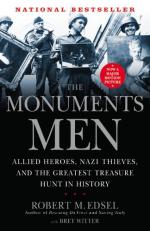|
This section contains 573 words (approx. 2 pages at 400 words per page) |

|
The Monuments Men Summary & Study Guide Description
The Monuments Men Summary & Study Guide includes comprehensive information and analysis to help you understand the book. This study guide contains the following sections:
This detailed literature summary also contains Topics for Discussion on The Monuments Men by Robert M. Edsel.
The Monuments Men: Allied Heroes, Nazi Thieves, and the Greatest Treasure Hunt in History is a nonfiction book by Robert M. Edsel and Bret Witter. This book tells the true story of a group of Allied soldiers whose job it was to protect and rescue historical architecture and art of all forms. Most of these soldiers worked with art in some way in their civilian lives and wanted to help protect the great art of Europe in face of the destruction of war. These men also found themselves saving priceless works of art stolen by Hitler and his Nazi soldiers, art that might have been lost to the world if not for the efforts of a few, brave individuals. The Monuments Men is a book that tells a story that has been long ignored.
The Monuments Men is a group of men and women who worked for the Monuments, Fine Art, and Archives, or MFAA during World War II in an effort to preserve fine art, documents, and monuments. These people traveled throughout Europe closely behind allied troops in an attempt to locate and preserve art. However, the Germans managed to steal many works of art from the beginning of the war. This allowed them to take the art and hide it throughout Germany and Austria for Hitler’s grand plan, a cultural center much like the one in Florence, Italy.
As the war began, a soldier noticed the destruction of monuments in Africa and suggested that actions be taken to protect them. At Monte Cassino, an ancient monastery was destroyed in an attempted to remove German soldiers from its walls. The Germans were never inside the monastery. These events inspired allied leaders to find a way to protect these monuments as well as fine art.
The MFAA was formed. Several soldiers with a career in art or architecture, were chosen. These men were soon sent into the trenches, many beginning in France after D-Day. These soldiers traveled to known monuments to assess the damage, if any, and to post notices to protect them from further damage. Many of these soldiers traveled with the same army throughout their time in the war, some were stationed in specific areas, others moved from post to post.
As the Allied troops continued forward, the Germans began to retreat. As they did, some soldiers continued to steal art as they went. These thefts included the theft of the Bruges Madonna and the Ghent Altarpiece. These thefts encouraged the Monuments Men to begin looking for caches of art. In Paris, one soldier, Rorimer, made the acquaintance of a woman who worked in the Jeu de Paume in Paris and kept note of the works of art that passed through there during the occupation and where they went. With her help, Rorimer was able to find a large cache of art and records of the art stolen.
By the end of the war, the Monuments Men had found multiple repositories of art, including one that had thousands of bars of solid gold. One of the largest repositories was almost destroyed prior to the allied troops arrival. Hitler had issued a decree before his death instructing his men to destroy all documents and artwork that might fall into allied hands. The Gauleiter in Altaussee believed this included a salt mine there that contained hundreds of irreplaceable works of art. However, the man was outsmarted. The mine remained intact.
Read more from the Study Guide
|
This section contains 573 words (approx. 2 pages at 400 words per page) |

|



